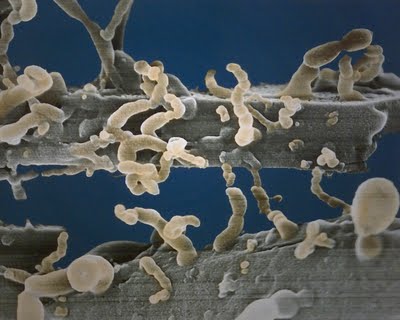 Nanobes - Are they alive? |
Lab Summary
This case-based guided inquiry lab challenges students’ conceptions of what it means to be alive. Prior to lab students are confronted with a brief case study involving disagreements among scientists about whether nanobes should be classified as alive. At the start of lab students are asked to determine whether a number of common “things” (potatoes, bean seeds, bare twigs recently cut from a bush etc…) are alive. Disagreements that emerge among lab teams are addressed by asking students to develop a protocol to test their "life" hypotheses, by looking for signs of metabolism (CO2 uptake or release). The lab explores/challenges student’s conceptions of life, and gets them to consider how a scientist might determine whether or not something is alive by introducing students to aspects of experimental design (forming a hypothesis and experimental prediction, measurements of biological processes, negative controls, use of descriptive statistics, graphing). The lab also exposes students to the hardware and software which will be used in future labs as they explore aspects of metabolism. |
Conceptual Objectives
- To develop a deeper understanding of the properties of life.
Scientific Skills Objectives - In the context of this lab students will practice and receive feedback on
- understanding the conceptual relations between a biological process and a quantitative measure of that process.
- developing and justifying an experimental hypothesis and prediction.
- designing an experiment with appropriate positive and/or negative controls
- recording, organizing, summarizing (descriptive statistics and graphing) data in a MS Excel spreadsheet.
Learning Theory & Pedagogy
This lab challenges students' understandings about the
nature of life (What is life?), and how we might
determine whether or not something is alive. Why
challenge students' conceptions? Learning theory
suggests that students hold tightly to their
understanding (often misunderstanding) of the
world. To meaningfully change a student’s
conceptions, they must be put in a situation that
challenges his or her current conceptions and creates
cognitive dissonance. This simply means that
students come to realize that a new understanding is
needed to explain that which simply does not fit their
current understanding. What is most
important is that this dissonance is fostered in a way
that is not threatening to individual student, and which
evokes a renewed sense of wonder.
Although the question of
whether something is alive or not is seemingly obvious,
students typically disagree about whether or not common
things they have had direct experiences with (a potato
or apple seed) are alive. Moreover students also
discover that scientists themselves often disagree about
whether or not things we find in nature are alive (i.e.
viruses and nanobes). The cognitive
dissonance created in the early stages of this lab
combined with students' intrinsic interest in question
related to the nature of life (Does life exist on other
planets? How can life exist in seemingly inhospitable
places such as around hot springs, undersea
hydro-thermal vents, and miles below the earth’s
surface?). Fortunately we don’t need to go to
these extreme places to challenge students thinking
about what defines life. There are many things
around us in our daily lives which generate some
uncertainty among students as to whether or not they are
alive.
This lab is also meant to directly confront the
following common misconceptions that students have about
basic tenets of science
• Experiments “prove” (rather than
provide support) a hypothesis.
• Only professional scientists are
capable of doing science, or making good decisions about
science related issues.
• Science is a collection of facts and
ideas that must be memorized.
• Scientific knowledge never
changes...it yields unchangeable truths about the world.
• If variable A increases with
variable B, then this alone is evidence of causation…A
causes B to increase. (Ignoring the importance of
experimental controls.)
Instructional
Resources
- An instructor guide which provide lab instructors with pre-lab preparation instructions, suggested materials, learning theory and pedagogical suggestions.
- Instructor PowerPoint presentation which challenges students' ideas about the nature of life and prompts further discovery.
Materials Required
- Vernier data logger and gas sensors (O2 and/or CO2)
- Team computer
with access to MS Excel